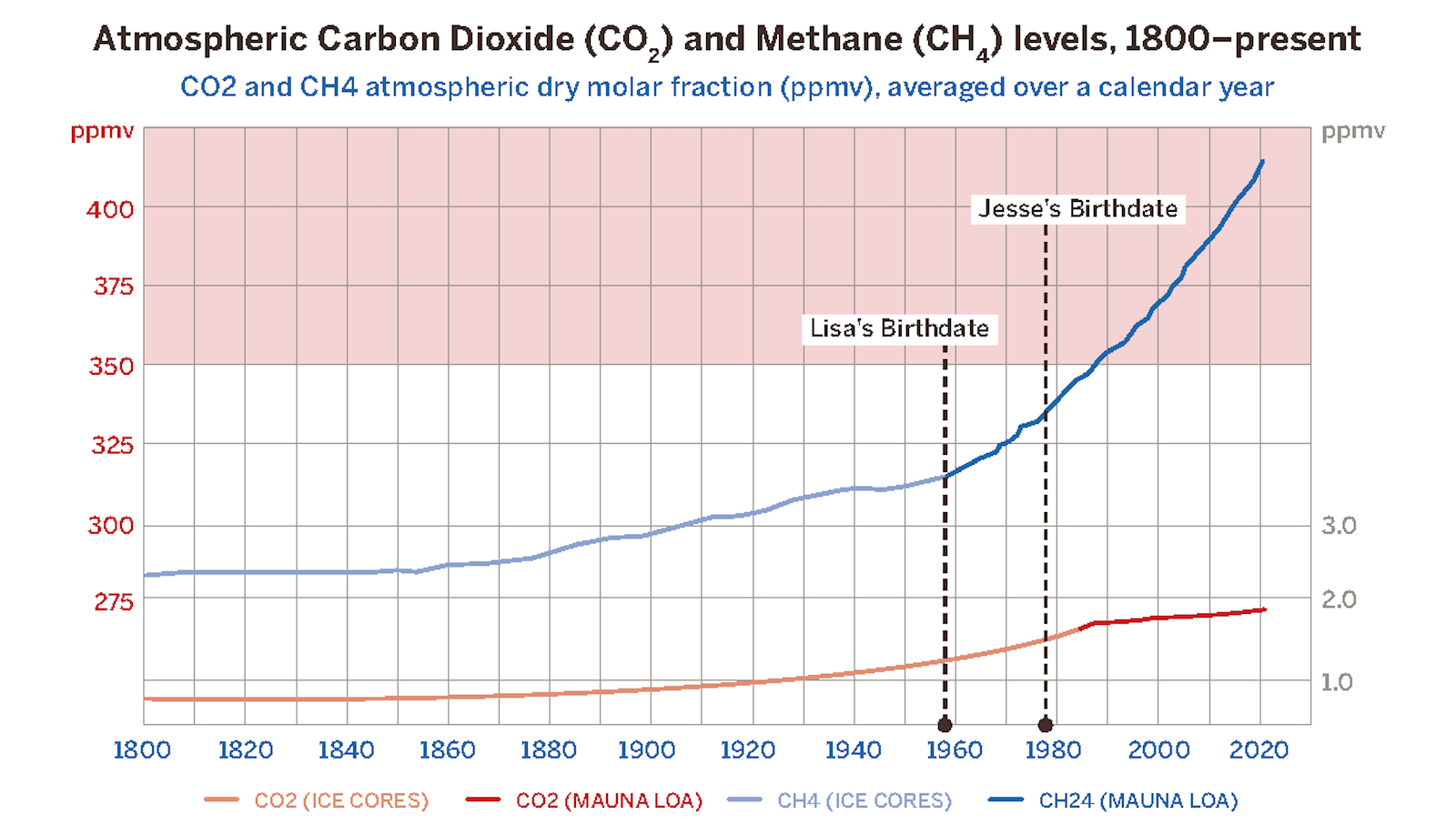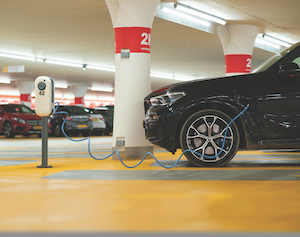How to Meet Your Climate Responsibility
Design gas out of your life. Then design it out of your town.

Changes in global average temperature from 1850 to 2020 by Ed Hawkins, professor of climate science at the University of Reading, UK. “The planet is warming due to human activities, primarily burning fossil fuels and deforestation.” See here for details.
By Lisa Cunningham and Jesse Gray
Your story may be very similar to ours. Like us, you are probably already worried about climate change. You’ve noticed that dire news of our rapidly warming earth is no longer just from distant parts, affecting people and places we see only in photos.
Extreme heat (1) has come to our own backyards. (2) Massive fires have hit those we know and love. The same with extreme storms and flooding. The news is no longer just about starving polar bears, retreating glaciers, and collapsing ice sheets. It’s about tipping points, an increasingly hot planet, (3) with greenhouse gas concentrations hitting record highs (4) and destined only to go higher. (5) Two of the most conservative organizations—the International Energy Agency (6) and the UN International Panel on Climate Change (IPCC) (7)—have recently issued the same stark warning: in order to avoid catastrophic climate change, we must stop using fossil fuels immediately.
As we write, record breaking heat, (8) drought, fires, and smoke are being felt all over the United States. But let’s be very clear—our climate crisis doesn’t affect everyone equally. It disproportionately affects those most at risk (9) who suffer at the expense of our wasteful policies, with higher temperatures and a lack of clean air and clean water, resulting in significantly worse health outcomes and opportunities. It disproportionately affects those in sacrifice zones (10) living in the shadow of toxic oil and gas operations, workers unable to escape this extreme heat, (11,12) as well as those living in tropical climates and flood-prone areas, causing mass migration (13) and upheaval across the world. Due to racism and economic inequality, these burdens fall disproportionately on Black and brown and low-income people all over the world, including here in the United States.
One of us, Jesse, was born at 332 parts per million (PPM) CO2. In 2017, he awoke from climate denial and made it his hobby to design gas out of his life. For what it’s worth, Jesse is a neurogenomicist by day who did not contest the science of global warming. Rather, his denial was the denial that arises in all of us when we mean well but can’t quite figure out what to do to help. He had despaired every time he filled up his gas tank, but he hadn’t known what to do differently.
For the other of us, Lisa, an architect and designer, born at 315 parts per million CO2, “energy efficiency” used to be the mantra. Gas was better than oil—or that was the well-accepted story—more insulation was better than less, and creating an airtight building was good enough. At a certain point, she awoke and realized that “efficiency,” while critical, was not going to get us to where we need to go, because we can’t “efficiency” our way to zero emissions. Even an “efficient” gas furnace still produces 100% greenhouse gas emissions for decades, emissions that we can no longer afford any of, not in the future and not now. The same with our internal combustion vehicles, no matter if they are sippers or guzzlers. Efficiency alone won’t get us to where we need to go fast enough.
Now at 419 PPM CO2, (14) we have come to a personal reckoning, as an architect, a scientist, and as frustrated climate activists. We realized that the actions that we had been taking, while more than what most people do even now, were not enough. Prior to the reckoning, we had worked on climate committees, voted the Democratic ticket, (15) attended rallies, and bought 100% green, renewable electricity. At the same time, we were also driving cars that still used gasoline and burning methane (16) by using multiple gas appliances inside our own homes.

The authors, Lisa Cunningham and Jesse Gray, with students and colleagues upon passage of Brookline’s first building electrification bylaw.
In fairness to Jesse, Lisa, and all of us, it wasn’t until the past few years that it became truly practical to take significant personal action on climate. Most of us haven’t yet fully absorbed this new information, and there is a reason why. The oil and gas industry, who have been in a decades-long denial and cover up (17) of the severe consequences of climate change, and continue to actively undercut climate action, (18) don’t want you to know this. The mainstream media (19) hasn’t been helping, either.
We knew that fossil fuels—gas, oil, methane and in fact all “combustion” fuels—were killing us, (20) producing emissions that are incompatible with the future of life as we know it. (21) But we now know that we don’t need them. We have come to understand that gas is not the “clean” fuel that the oil and gas industry have been promoting and glamorizing. We have learned that gas is as polluting as coal, emitting methane, (22) a far more potent greenhouse gas than carbon, from leaky pipelines and old gas infrastructure, (23) and from burning and leaks from wells, not to mention the devastating effects of gas extraction from fracking. (24)
The good news is that life—and design—is actually better without gas and other fossil fuels. It’s not a sacrifice. Not only is all-electric technology necessary to reduce our carbon emissions, eliminating combustion (25) (from ALL sources, including wood and biomass) produces cleaner air and significantly improved health outcomes. The technology is here, we just need to embrace it. (26) And as in all technological advances—think computer and cellphone technology—embracing this change is not just a scientific and moral imperative, but will also spur job creation and promote enormous economic opportunity.

Everyday Options for Environmentally Friendly Alternatives
If you drive a car, it’s much nicer—and a lot more fun—to drive an electric vehicle. (27) You can pre-heat and pre-cool from your phone— even in a closed garage, without the risk of death by asphyxiation! You don’t have to make a special trip to get gas. Instead, you leave every morning with a full charge. For those without a charger where they live, which is many of us, public charging stations make electric car ownership practical for condo owners and renters. And for those who care about performance, electric motors respond instantly, providing full torque from a standstill and rivaling even the sportiest of conventional gas-combustion vehicles.
Even as we switch to all-electric vehicles, we can be healthier and reduce our emissions even faster by advocating for, and using if possible, public transit. EV technology is also being adopted for school buses, public transit, and public works vehicles, which will lead to cleaner air and eventually zero emissions in these sectors.
Life is healthier and more comfortable at home without gas, too. Heat pumps—we are not talking the old resistance heat of decades ago—provide more comfort than fossil fuel combustion furnaces, supply both heating and cooling in the same system, and operate with high efficiency, even in cold climates like New England. Induction ranges have the power to boil water almost twice as fast and heat more evenly than gas, and are in widespread use throughout Europe and the rest of the world. All this without spewing dangerous pollutants like carbon monoxide, nitrous oxide and formaldehyde into your home, (28) and significantly increasing your children’s risk of asthma and other harmful health effects, which can’t be said of your gas stove.
In short, it makes sense to design fossil fuels out of our lives and work, starting now. There is a lot of work to be done. The bar will keep going up. Yesterday it was hybrids, but today it’s electric vehicles. Yesterday it was converting from oil to gas, but today it’s converting from gas to electric. Tomorrow, we will begin to dismantle the gas grid.
The apparent magnitude of what needs to be done exhausts the human psyche, and it’s one reason we haven’t acted faster—we don’t know how to start. But instead of thinking of reasons why we can’t do something, we need to start thinking of why we can. (29) We can’t wait for perfect solutions, or solutions that don’t require us to do anything, or solutions that everyone, including the oil and gas industry, can agree to. We need to inject climate, as a priority, into absolutely every aspect of our lives, right now. (30) Our car purchases, our home improvement projects, our daily conversations, our design efforts, and our messaging. (31)
It helps to keep it simple, and focus on what’s most impactful. Here’s simple: get rid of gas. Start by designing gas out of your life. It’s easier than you think. Start with your appliances: your cooktop or range, your water heater, your clothes dryer. Replace your car, or ditch it altogether, and when you can, your furnace as well. Never go to a gas station or to get an oil change again. Get a free home energy audit, (32) replace your lightbulbs, and sign up for 100% renewable energy. (33) For extra credit—and to add money into your bank account—install solar panels on your roof or condo building if feasible, further reducing your energy needs while taking full advantage of federal (34) and state (35) subsidies. Design gas out.

Graph source: Architecture 2030 and IPCC SR15, Table 2.2
But this isn’t just about individual choices. That is just a first step, and not an option for many of us. However, those of us that can make these changes need to do so, and as quickly as possible. Consumer demand creates more demand, changes false perceptions fueled by oil and gas industry lobbying, (36) and leads to lower costs and more innovation, (37) eventually benefiting everyone, even those who are not able to take these first steps.
This is also about creating a movement, and to do that, we need everyone on board. Yes, you. A movement takes more than tweets, posts, protests, and personal action. In order to do what needs to be done, no one can afford to stay on the sidelines any more. Individual actions need to be backed up by the power of activism, and those of us who have the privilege of time and money must participate to the fullest. For systemic change, we need laws at all levels of government to support our actions. (38)
So, if you’re feeling ambitious, and we know you are, take the next step and design it into law. Right now, local law is the law that is hardest for the fossil fuel and dark money interests to fight. Local law is the law that can be written by volunteer citizens not beholden to fossil fuel interests. Local law bends first to our will, as the first record of a new political consensus.
What do we mean by this? Beginning in 2019, a new local law in California banning gas in new buildings spread from Berkeley to San Jose, soon Sacramento, and then to almost 50 towns and cities in CA. (39) This law denies building permits for projects that would install gas systems during new construction. It protects you, as a property owner or renter, from builders, architects, and landlords who are wasting your time and money by installing systems that actually have to be replaced so that we can meet our climate targets. This new law is a practical step, as well as a fiscally conservative one.
The law leapt from California to the Boston suburb of Brookline, MA, where we copied Berkeley and took it further, in spite of our cold weather climate. Our legislation (40) prohibited fossil fuel systems not only in new construction, but also in gut renovations. We also added practical exemptions and a waiver process, to ensure that our bylaw could be easily implemented. This legislation passed overwhelmingly in Brookline because we convinced our Town Meeting that fossil fuel free construction is both practical and cost-effective, particularly at the point when systems are being replaced or installed. Just as importantly, it makes no fiscal or moral sense to install new fossil fuel systems that are designed to last for 30 years or more, well past the point when we know we must be carbon free.
After we passed our bylaw, we had many towns and cities contact us to say that they wanted to follow in our footsteps and pass similar legislation. This interest led to the launch of a statewide building electrification movement, a movement that has grown and spread throughout the state and beyond as many municipalities recognize the practicality, the urgency, and the fiscally prudent path of pursuing net-zero (41) and fossil fuel free construction. (42) With the Brookline by-law in mind, the Massachusetts state legislature, with recent climate legislation, (43) opened the door a crack. Backed by the knowledge that municipalities all over the State are clamoring for action, (44) our state legislators even stood firm when the governor twice balked and tried to veto the critical building electrification components of this legislation. This is progress.
And yet, the progress is not fast enough or certain enough, and it is still no more than studies and talk. In Massachusetts, National Grid and Eversource are in sync with national oil and gas industry talking points (45) and just formed a regional gas-promoting cabal called the “Consortium to Combat Electrification.” (46) Governor Baker set an important goal, including decarbonizing one million existing Massachusetts buildings in the next nine years and 300-400 million square feet of commercial real estate, (47) but there is no plan (48) or political path to make that happen. Instead, we are building new buildings every day with fossil fuel systems that will need to be replaced well before their useful lives are up, at far greater cost.
Our first Brookline by-law was struck down during legal review by the Massachusetts Attorney General Maura Healey. While expressing full support for our policy goals, (49) she ruled that we had run afoul of competing legal priorities legislated long ago, including a right for utilities to sell gas. These are not the priorities we should have, but unlike California, it is the state law that we do have.
Undeterred, we have continued to press ahead to find other legal mechanisms to circumvent these outdated and counter-productive legacy laws. In December 2020, we passed a Home Rule Petition asking the State Legislature to allow our 2019 bylaw. A mere six months later, four other Massachusetts towns had already followed suit, with more municipalities in the pipeline. (50)
Most recently, in early June 2021, we took yet a further step here in Brookline, taking another shot-on-goal with a new by-law. It does not ban gas, but it creates a strong disincentive to build with gas. It applies only to projects that require zoning relief, which is a lot of projects in our town. Still subject to review by the Attorney General, this legislation (51) sends a clear signal: if the state can’t get started, then municipalities, beginning with Brookline, will drag it kicking and screaming into the future.
This is already a story about the power of grassroots local assertiveness. Our local action, even with legal setbacks, has spurred both more local and statewide action. And state action spurs federal action.
Now we are asking for your help. Take a step yourself, in your own life, toward getting rid of gas, and then go one step further: get others to do so as well. If you are a designer, an architect, or a planner, then you are both a communicator and a problem solver, and you wield a lot of power. Use that power. Be a Clean Creative. (52) Counter the lies and the misinformation, design your projects (53) and your life without fossil fuels. Communicate the urgency of this problem, join one of the many groups that are fighting for change. Start with your own community and act as though your life—and your children’s lives—depend on it. Because it really does. (54)
Then, identify local legislation that could be impactful, practical, and politically possible in your community, wherever you are. We can help. We weren’t experts, and you don’t have to be either. Join or form a team of committed volunteers. Connect with allies. Meet the local power brokers. Draft an ordinance or by-law. Incorporate feedback. Get it passed. Does your community have a community choice electricity program? If not, start one. Are your schools and municipal buildings being built to net-zero standards? If not, make sure they are. Electrify your municipal fleet and clean your community’s air while protecting our children all at the same time. In every community that has done this—and there are too many to count—an individual just like you was the catalyst for these actions. Be that person.
We all need to change, and to convince others to change. Join us, and you may find, as we did, that there are rewards not only in changing the minds of others, but also in changing ourselves.
ELECTRIC VEHICLES
The most important climate action many of us can take right now is to resolve to never again buy a gasoline vehicle. Transport is one of our biggest daily climate impacts—at about 30% of US emissions—and it’s also one of the easiest and most pleasurable impacts to reduce. Resolving not to buy another gasoline vehicle has never been more practical.
If you drive, it’s easier than you think to go fully electric. It’s not only an upgrade, but also the total cost of ownership is also lower for electric vehicles, since maintenance and fueling are typically far less expensive. With state rebates and federal tax credits, many electric cars can also be relatively inexpensive upfront to obtain.
In Massachusetts as of this writing, you can buy the Hyundai Kona, far greener than a Prius, for less than $25,000, nearly half of the average price of a new vehicle; or you can lease it for $265 a month. A base model Tesla Model 3 can be purchased for $550 a month or leased for $390. [Kona pricing net $7500 in federal incentives (no longer available for GM or Tesla) and $2500 in MA state incentives.]
While you might think you need unlimited range (which isn’t possible in a combustion vehicle either), it’s plenty practical and pleasurable instead to stop for 15-20 minutes to stretch your legs, gaining a hundred miles of range at a level 3 charger while on a bathroom break, coffee break, or grocery run. Talk to an EV owner—once you’ve gone electric you can never go back!
References fueleconomy.gov/feg/taxevb.shtmlevcharging.enelx.com/resources/federal-and-state-electric-vehicle-incentives

INDUCTION COOKING
Induction cooking uses a magnetic field to heat up cookware and efficiently cook food without losing heat to surrounding areas or emitting harmful gases such as formaldehyde, nitrous oxide, and carbon monoxide, thus making it more efficient and safer. It is faster (water boils almost twice as fast) and more finely tuned (you can melt chocolate without a double boiler). Because there is no combustible gas, the risk of kitchen fires and explosions is greatly reduced. Cleaning a flat glass surface is easier. In widespread use all over the world, US consumers have been late to embrace this clean and healthy technology, in part due to oil and gas industry propaganda. Still, many top chefs and hotel restaurants in the US use induction. In our anecdotal experience, cooking with induction is a lot like driving an electric vehicle—once you try it, you will be hooked.
Induction stoves are available as plug-in hotplates, cooktops, and ranges. Getting a new cooktop or range can be expensive if you aren’t already overhauling your kitchen, particularly because induction ranges typically require electrical outlets that may not be running to your stove already. A great alternative is a portable induction cooktop; including the cost of new magnetic pans, this can cost less than $150 all-in.
References
rmi.org/insight/gas-stoves-pollution-health
www.nytimes.com/2019/05/01/opinion/climate-change-gas-electricity.html
www.wnycstudios.org/podcasts/otm/segments/fight-over-natural-gas-stoves-are-wedge-issue-on-the-media

WE NEED MORE THAN TWEETS AND LIKES
Get involved and join those working for change. Contact:
- Your town/city climate action committees (often there are several—some are connected to local government, others are citizen run).
- Most of the state/national organizations listed below have local town and city chapters.
- Climate activists need more political power. Become a Town Meeting member (as we did) or run for City Council or higher office.
Some state and national organizations. These are a few ideas, but there are many, and many more who need both your financial contributions as well as your time and advocacy:
350.org
Sunrise movement sunrisemovement.org
Environmental Voter Projectenvironmentalvoter.org
RMI rmi.org
Mothers Out Front mothersoutfront.org
Elders Climate Actioneldersclimateaction.org
Climate Xchange climate-xchange.org/network
Extinction Rebellion rebellion.global
Sierra Club sierraclub.org
You can contact us at zerocarbonma@gmail.com
(1) www.washingtonpost.com/weather/2021/06/16/heat-wave-west-record-temperatures/
(2) www.nytimes.com/2021/07/17/climate/heatwave-weather-hot.html
(4) thebulletin.org/doomsday-clock/current-time/
(6) www.nytimes.com/2021/05/18/climate/climate-change-emissions-IEA.html
(7) www.theguardian.com/environment/2021/jun/23/climate-change-dangerous-thresholds-un-report
(9) www.niehs.nih.gov/health/materials/climate_and_human_health_508.pdf
(12) www.nytimes.com/2021/07/15/climate/heat-injuries.html
(13) www.politico.com/news/magazine/2021/07/19/guatemala-immigration-climate-change-499281
(14) www.sealevel.info/co2_and_ch4.html
(15) www.nytimes.com/2021/06/30/opinion/climate-change-congress.html
(16) www.nytimes.com/2021/04/24/climate/methane-leaks-united-nations.html
(17) www.theguardian.com/business/2016/may/20/oil-company-records-exxon-co2-emission-reduction-patents
(18) www.nytimes.com/2021/06/30/climate/exxon-greenpeace-lobbyist-video.html
(21) www.theguardian.com/environment/2021/jun/23/climate-change-dangerous-thresholds-un-report
(22) www.nationalgeographic.com/environment/article/methane
(23) rmi.org/a-new-approach-to-americas-rapidly-aging-gas-infrastructure/
(24) www.psr.org/blog/resource/fracking-compendium/
(25) www.hsph.harvard.edu/c-change/news/gas-biomass/
(27) www.hsph.harvard.edu/electric-cars/
(28) rmi.org/insight/gas-stoves-pollution-health
(29) heated.world/p/what-can-i-do-anything
(30) www.hsph.harvard.edu/magazine/magazine_article/no-time-to-waste/
(32) www.masssave.com/
(33) www.epa.gov/greenpower/community-choice-aggregation
(34) www.energy.gov/eere/solar/homeowners-guide-federal-tax-credit-solar-photovoltaics
(35) www.dsireusa.org/
(36) www.facebook.com/watch/?v=915740298972039
(39) www.sierraclub.org/articles/2021/07/californias-cities-lead-way-gas-free-future
(40) www.brooklinema.gov/DocumentCenter/View/20839/ARTICLE-21-as-voted-per-Town-Clerk?bidId=
(41) builtenvironmentplus.org/wp-content/uploads/2021/03/MAisReadyforNetZero_03.01.21.pdf
(42) rmi.org/insight/the-new-economics-of-electrifying-buildings/
(43) www.wbur.org/earthwhile/2021/03/26/new-mass-climate-law-faq
(44) docs.google.com/document/d/1NPqPOnF1oTdZ5YWtbIPVSFzautS-A7L1KcFIv0MP-Pk/edit
(45) www.fastcompany.com/90621117/the-oil-and-gas-industry-is-in-denial-about-its-own-demise
(47) www.mass.gov/doc/interim-clean-energy-and-climate-plan-for-2030-december-30-2020/download
(49) www.boston.com/news/local-news/2020/07/22/maura-healey-brookline-oil-gas-ban-ruling/
(53) www.aia.org/resources/202041-the-2030-commitment
(54) www.nytimes.com/2021/08/19/opinion/climate-un-report-greta-thunberg.html
